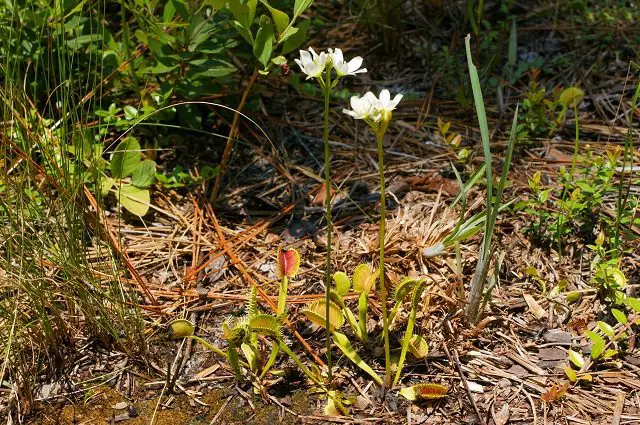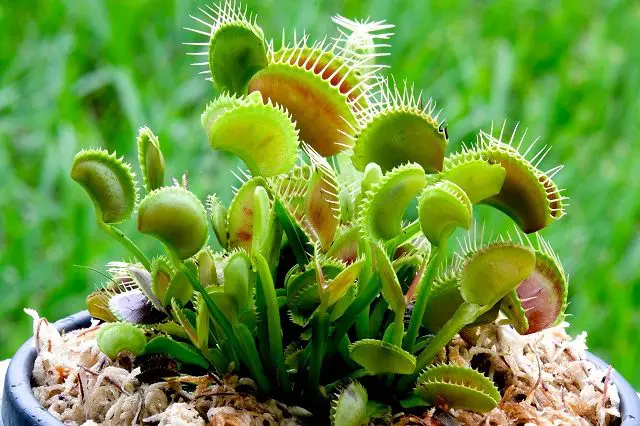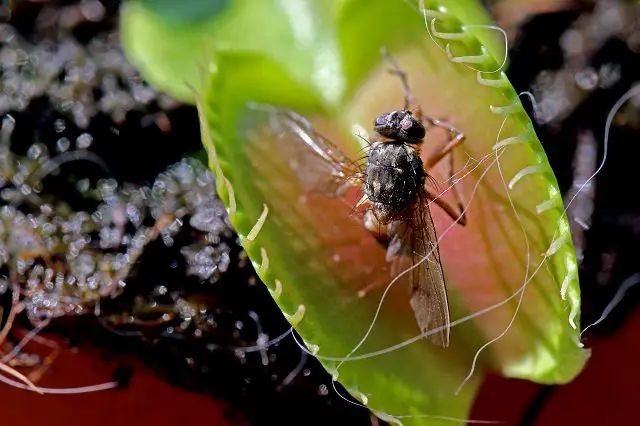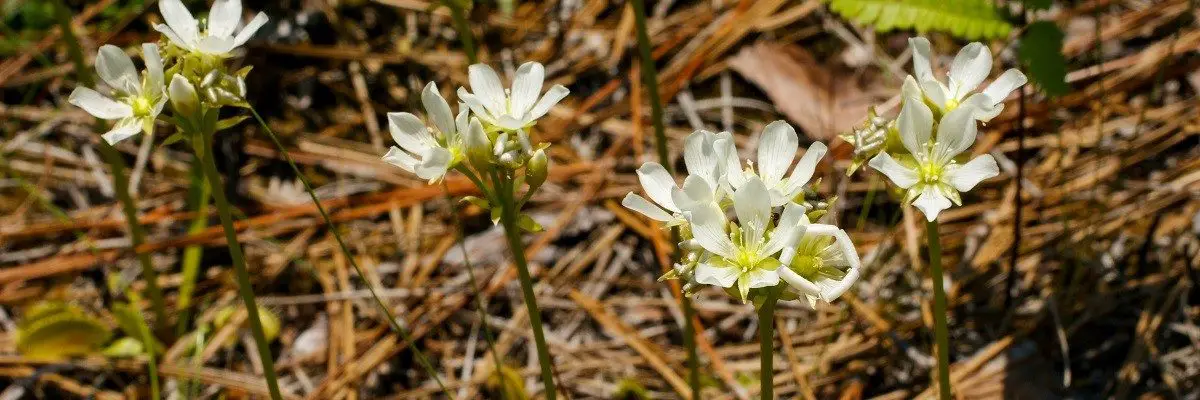Venus Flytrap Flowers: Have you ever marveled at the captivating beauty of a Venus flytrap flower? Its five petals, delicately opening and closing like a mysterious trapdoor, are truly a sight to behold. With its sweet nectar, it lures in pollinators like bees and other insects while also playing an essential role in plant reproduction. These unique flowers have delighted botanists for centuries with their remarkable ability to capture and digest prey. In this article, we will explore the anatomy of these beguiling blooms, how to stimulate flowering, their lifecycle, varieties, benefits for the plant, and various uses. So come join us as we discover all that these intriguing Venus flytrap flowers have to offer!
Anatomy of a Venus Flytrap Flower
You’ve probably heard of the famous Venus Flytrap; did you know that its flower usually has about 5-15 white petals? The flower stalk is quite tall, keeping pollinators away from the dangerous traps. Up close, these flowers look like delicate white structures. Inside the middle of the flower is a ring of yellow stamens and pistils, which act as pollen receptors for pollinating insects.
The Venus Flytrap has leaves divided into two regions: a flat petiole and a pair of terminal lobes which comprise the snap trap. The traps contain sensitive hairs; when an insect brushes against these triggers twice in quick succession, it causes the lobes of the leaf to snap shut, trapping whatever was unlucky enough to wander inside!
Venus flytraps thrive in wet boggy areas where there is plenty of water and nutrients available for them to absorb through their roots. The plants prefer full sun exposure but should be protected from extreme temperatures. They need a good amount of sunlight, but not necessarily 14 hours a day as it may lead to scorching.
Taking care of a Venus Flytrap is quite simple; just make sure it gets enough sunlight and water regularly! If you want your plant to stay healthy and strong, avoiding fertilizers is best, as they’re adapted to survive in nutrient-poor soils and they get most of their nutrients from the insects they catch.

How to Stimulate Flowering
Stimulating blooming can be a challenge, but it doesn’t have to be! In order to encourage the growth of beautiful Venus flytrap flowers, there are a few steps you need to take. Firstly, make sure your plant is healthy and well-fed. This means providing plenty of sunlight and water with good drainage so the soil does not become soggy or dry out too much. Secondly, instead of fertilizing your plant, ensure it has access to insects to provide the necessary nutrients. Lastly, prune away any dead leaves or stems that may inhibit new flower buds from forming.
When spring comes around, you should also move your plant outdoors as this will help stimulate flowering. Make sure they are placed in an area that provides partial shade and protection from strong winds as these could damage delicate petals and leave them vulnerable to pests and disease.
Lastly, if you have been growing your Venus flytrap indoors for quite some time without seeing any flowers appear yet, don’t worry! Sometimes plants need more time before they reach full maturity and begin blooming again – just keep caring for them consistently with patience and dedication until they do! With correct care and tending, these unique plants will reward you with their remarkable beauty when given enough time – it’s worth the wait!
Pollination and Fertilization
Once the flowers have emerged, pollinating and fertilizing them is an important step in ensuring their growth. Pollination serves to transfer pollen from male parts of the flower to female parts, allowing for fertilization. This process allows the Venus flytrap’s flowers to produce seeds which can be planted and will eventually grow into new plants. Fertilizing helps to ensure that each plant has access to all the necessary nutrients it needs for healthy development. Here are four key steps you can take to make sure your Venus flytrap flowers get the care they need:
- Make sure your flowers are getting enough sun – Venus flytraps in particular need a lot of sunlight in order to thrive and produce seeds.
- Monitor humidity levels – these plants require high humidity levels in order for blossoms and seeds to form properly; using a humidifier or misting with water can help keep things just right!
- Pollinate by hand – if there aren’t enough bees around, use a clean paintbrush or cotton swab to manually move pollen from one flower’s male part (anther) onto another’s female part (stigma).
- Fertilize regularly – adding fertilizer specifically designed for carnivorous plants helps provide essential nutrients not found in soil alone, helping ensure successful seed production through fertilization.
It’s also important that you watch out for any signs of pests or diseases that could harm your plants: keeping an eye out for aphids or slugs, as well as making sure leaves aren’t turning yellow due to lack of nutrition, are critical steps you can take when caring for your Venus flytrap flowers! With proper attention and care, it won’t be long before you have a thriving garden full of beautiful and unique blooms!

The Lifecycle of a Venus Flytrap Flower
The lifecycle of a carnivorous flower can be quite fascinating, from pollination and fertilization to the emergence of new blooms. Venus flytrap flowers are no exception! When in bloom, these plants produce reddish-pink petals that are slightly frilled at the edges. The delicate plants attract pollinators like bees and butterflies with their sweet scent.
Pollen is collected by the insects and transferred to other flowers as they move around. This process allows for cross-pollination between different Venus flytrap species. After successful pollination, fertilization takes place within the anthers of each bloom. Once completed, seeds begin to form within the flower’s ovules which will later mature into new blooms:
| Step | Description | Timeframe |
|---|---|---|
| Pollination | Insects collect pollen from flower blooms | 2-3 weeks after flowering begins |
| Fertilization | Pollen transfers to other flowers, allowing for cross-pollination between different species of Venus flytraps | 1 week after pollination starts |
| Seed Formation & Maturation | Seeds form within the ovules and mature into new blooms once conditions are favorable for growth (temperature, light intensity) | 1 – 4 weeks after fertilization is complete |
These steps repeat themselves throughout each life cycle until eventually all flowers have withered away and died back for another season. With careful attention and proper care, you too can enjoy watching this captivating process unfold again and again!

Varieties of Venus Flytrap Flowers
Bursting with vibrant colors, these carnivorous blooms come in many dazzling varieties:
- Cultivated Varieties:
- Red Piranha, distinctive for its red traps and tooth-like cilia.
- Big Mouth, known for its larger-than-average traps.
- Wild Varieties:
- Dentate Traps, a wild variety with serrated shaped cilia.
- Sawtooth Traps, which are characterized by their large size and sawtoothed cilia.
- Hybrid Varieties:
- B52s, a hybrid of the Red Piranha and Dentate Trap, characterized by its large traps and unique cilia.
- King Henry, a robust plant with large traps, similar to the Big Mouth variety.
No matter what type of Venus flytrap you choose to grow or admire in your garden or natural setting, there is something special about them that will captivate your attention and spirit! Their unique beauty can be enjoyed up close as well as from afar when they bloom in groups or clusters of different varieties together. To encounter these amazing plants is truly an awe inspiring experience that will stay with you forever!
Benefits of Flowering for the Plant
With their captivating blooms, these carnivorous plants, Venus Flytraps, add an intriguing dimension to any garden. However, contrary to some plants, the primary function of the Venus Flytrap’s flower is not to provide the plant with energy. The plant primarily derives its energy from photosynthesis and capturing insects.
Flowering plays an important role in the plant’s reproduction, offering a means to strengthen the plant’s genetic diversity through cross-pollination. Different varieties of Venus Flytrap can exchange genetic material, promoting a healthy and varied gene pool within the species.
Through seed production, the Venus Flytrap can spread itself across its environment, enhancing the chances of survival for future generations in times of significant environmental change or other adversities that might impact an individual population. This propagation process allows for better adaptation as the new plants can leverage available resources in their surroundings and potentially find more ideal growth conditions elsewhere.
Moreover, the flowering process can attract pollinators like bees and butterflies, aiding in the dispersion of pollen from one flower to another. This ensures fertilization and the growth of strong and healthy offspring. It should be noted, however, that the Venus Flytrap flower does not emit a notable aroma, which is a common characteristic of many flowers that attract pollinators.
The survival of the Venus Flytrap is further enhanced when they have access to resources such as sunlight, water, and insects – all of which are available in their native habitats. By ensuring that each generation has access to sufficient food sources during its developmental stage, the Venus Flytrap can continue to captivate and intrigue us for many years to come. However, it’s important to note that Venus Flytraps, like many other plants, should be allowed to grow without undue interference from humans or other creatures to maintain their health and vitality.

Uses of Venus Flytrap Flowers
The major point of correction is about the color of the Venus Flytrap flowers. The flowers are not pink, they’re generally white or slightly greenish. Also, it’s important to mention that Venus Flytraps are not used in large-scale conservation or reforestation projects. In fact, they are a vulnerable species and are protected in their native habitats in the US.
Here’s a corrected version:
For those looking to add an intriguing element to their outdoor spaces, Venus Flytrap flowers offer a fascinating sight. These delicate petals are usually white, sometimes with a slightly greenish hue, and can be used as accents or focal points in gardens and landscapes. They are fascinating and can also attract beneficial pollinators like bees and butterflies that can help pollinate other plants in the garden.
| Benefits | Uses |
|---|---|
| Attract Pollinators | Add Interesting Accents & Focal Points |
| Reproduce Plant Species | Provide Food Sources for Wildlife |
| Help Plants Thrive | Aid Individual Environmental Conservation Efforts |
Furthermore, by reproducing plant species through seed production, Venus Flytraps help ensure their own survival. Additionally, their flowers might attract certain insects, which could become food for the plant. Lastly, through individual environmental conservation efforts that protect endangered species of plants like the Venus Flytrap, we can create more resilient ecosystems.
Venus Flytrap flowers have long been admired by gardeners and nature enthusiasts alike due to their remarkable beauty and uniqueness in our environment; whether it’s adding intrigue to gardens or aiding individual conservation efforts – these captivating blooms are truly one-of-a-kind!
Frequently Asked Questions
How long does a Venus Flytrap flower live?
The lifespan of a venus flytrap flower varies depending on its environment and care. Generally, these plants can live for several months or even years when given the right conditions. Proper sunlight, warmth, humidity, and watering are key to keeping them healthy. It’s important to remember that these flowers need lots of love and attention, as well as proper maintenance. With the right care and dedication, you can ensure your venus flytrap flower will stay alive for many years to come!
Are Venus Flytrap flowers poisonous?
You won’t believe it, but these beautiful blooms are actually somewhat poisonous! Venus flytrap flowers may look innocent and gorgeous, but they contain a toxin that can cause mild irritation to those who come into contact with them. Although it’s unlikely to be serious, it’s still something to take caution around – especially if you’re sensitive or allergic to anything. So don’t be fooled by their beauty – these captivating flowers carry a hidden sting in their petals!
How do you care for a Venus Flytrap flower?
Caring for a Venus flytrap is easy! First, make sure you have the right environment: they do best in bright, direct light and need to be kept moist. Water your plant with distilled or rainwater – tap water may contain chemicals that are harmful to the plant. You should also fertilize your flytrap every two weeks, using either half-strength fertilizer or special liquid flytrap food. Finally, make sure it gets plenty of fresh air by keeping it in an open area with good ventilation. With these simple tips, you can keep your Venus flytrap healthy and beautiful!
How much sunlight does a Venus Flytrap flower require?
Like a houseplant in need of sunshine, your Venus flytrap flower thrives on light. Each day it requires at least six hours of direct sunlight to grow strong and healthy. Too little sun can cause the leaves to become limp and yellow, while too much can burn them. It’s like finding the secret balance that helps your flower blossom with beauty and vibrant health. With a regular watering schedule and plenty of bright, indirect light, you will soon have a happy, contented plant that is sure to bring joy into your home.
What is the best soil type for a Venus Flytrap flower?
Soil type is an important factor for keeping plants healthy and happy. For the Venus flytrap flower, it’s best to use a soil that is light, fast-draining, rich in organic matter and slightly acidic. A mix of sphagnum peat moss, sand or perlite, and vermiculite can provide the perfect balance of moisture retention and drainage. To ensure proper acidity levels for your Venus flytrap flower, add a small amount of horticultural sulfur to the soil mixture before planting.
Conclusion
You’ve come to the end of your journey with Venus flytrap flowers. You’ve learned about their anatomy, how to stimulate flowering, pollination and fertilization, their lifecycle, varieties, benefits for the plant, and even some uses. You may think you know everything there is to know about them now – but ironically enough, this remarkable little flower has plenty more up its sleeve!


